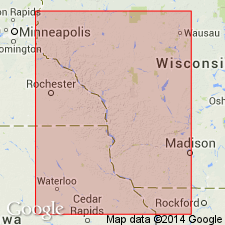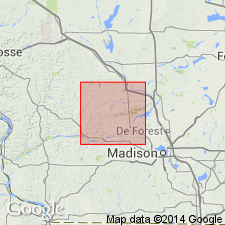
- Usage in publication:
-
- Norwalk sandstone member
- Modifications:
-
- Named
- Dominant lithology:
-
- Sandstone
- AAPG geologic province:
-
- Wisconsin arch
Summary:
Thickest and perhaps most important member of Trempealeau formation is the one at the top for which the term Norwalk sandstone member is proposed. Generally consists of fine-grained sandstone, sometimes nearly white and often with a yellowish or brownish tinge, commonly rather massive in upper two-thirds and more or less thin bedded and in even plates 1 to 6 inches thick in its lower third. Thickness 0 to over 40 ft; about 35 ft thick at Norwalk, Monroe Co. Has not been observed east of Cross Plains, in which region Trempealeau formation is terminated above by Lodi shale member, which underlies Norwalk sandstone member in the complete section. The Norwalk contains a large and varied fauna.
Source: GNU records (USGS DDS-6; Reston GNULEX).

- Usage in publication:
-
- Norwalk Member
- Modifications:
-
- Overview
- AAPG geologic province:
-
- Wisconsin arch
Summary:
Jordan Formation [in WI] is now generally considered to have two major subdivisions: the lower Norwalk and the upper Van Oser Members. The Sunset Point Member is present near the top of the Jordan in Dane Co., but has not been identified in the area of this report (Sauk Co.). The Coon Valley, considered here a member of the overlying Oneota Formation, was assigned to the Jordan by Odom and Ostrom (1978). The two members are distinguished by grain size. The Norwalk contains fine quartz sand, with some very fine and medium sand, and the Van Oser contains medium sand, with some fine and coarse sand. Norwalk also contains considerable feldspar. Members are mapped together is this report and total about 20 m. Scattered throughout the quartzose sandstone are thin beds of greenish-gray shale. The Jordan is, for the most part, nonglauconitic, noncalcareous, and nondolomitic. Planar and cross-bedded, locally bioturbated, and so interpreted as marine. Contact with underlying Lodi Member of St. Lawrence is abrupt. Age of the Norwalk shown in stratigraphic column as Late Cambrian. Age of Van Oser shown as Late Cambrian and early Ordovician.
Source: GNU records (USGS DDS-6; Reston GNULEX).
For more information, please contact Nancy Stamm, Geologic Names Committee Secretary.
Asterisk (*) indicates published by U.S. Geological Survey authors.
"No current usage" (†) implies that a name has been abandoned or has fallen into disuse. Former usage and, if known, replacement name given in parentheses ( ).
Slash (/) indicates name conflicts with nomenclatural guidelines (CSN, 1933; ACSN, 1961, 1970; NACSN, 1983, 2005, 2021). May be explained within brackets ([ ]).

